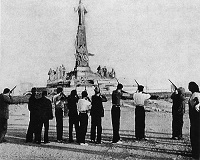056‐MD‐2021
July 1936. In the midst of the confusion that reigns after the military uprising carried out by a part of the Army and the revolutionary outbreak that the coup unleashes in different areas of the country, a group of militiamen goes to Cerro de los Ángeles, the geographic center of Iberian Peninsula, stands forming a firing squad before the statue-effigy raised in honor of the Sacred Heart of Jesus and shoots at it as if it were an execution. The image is collected in a photographic snapshot and a brief cinematographic sequence that produce an enormous impact on the press and the national and international media, fueling the idea that a "religious persecution" is taking place in Spain.
This image will not cease to circulate until today. However, neither its content nor its invoice have been unraveled or studied until today. This suggests that images have a decisive function in the constitution of historical memory, that they condense stories and that they are better remembered than complex and nuanced facts. Hence its plasticity. And it is that this scenario embodied one of the divisions of the Spanish between clericalism and anticlericalism. In 1919, Alfonso XIII consecrated Spain to the cult of the Sacred Heart of Jesus and this public recognition collides with the profane act and the subsequent dynamiting of the monument. Inaugurated in 1965 or a new monument, it was the scene of acts of reparation during the Franco regime.
- Sanchez Biosca, Vicente
- PDI-Catedratic/a d'Universitat
Rafael Rodríguez Tranche (Universitat Complutense de Madrid)
Ministry of the Presidency, Relations with the Courts and Democratic Memory










